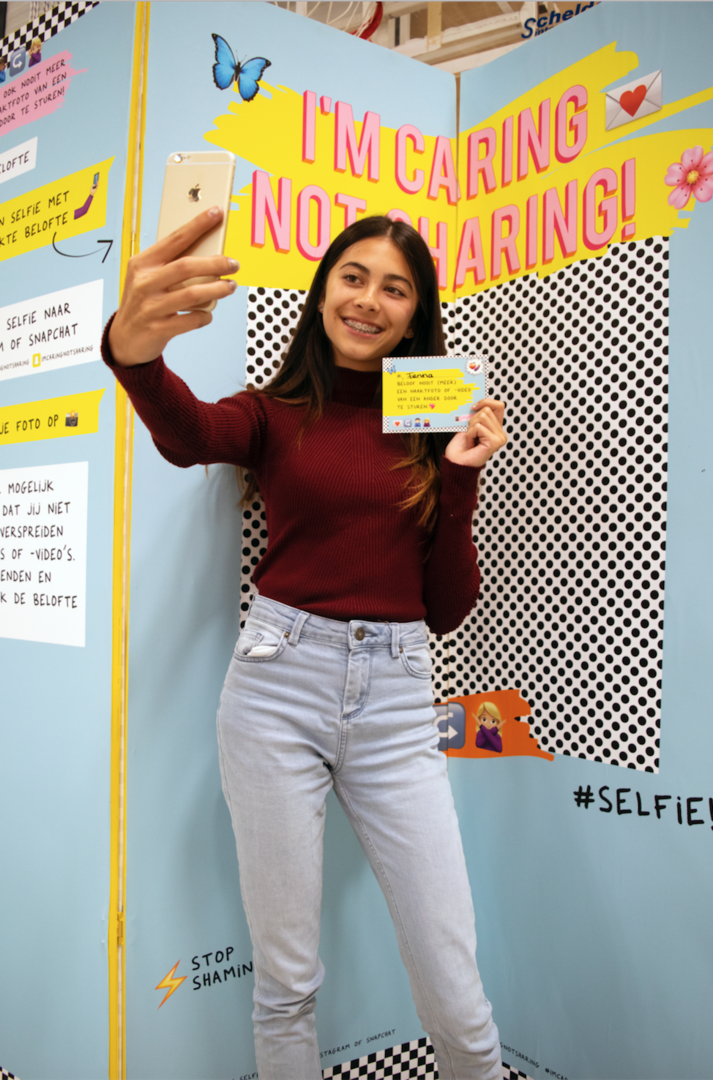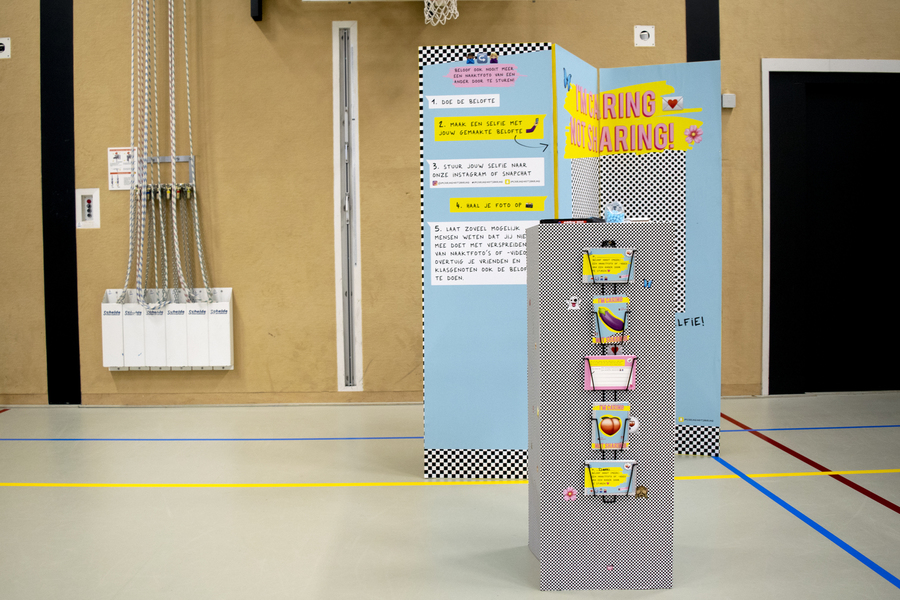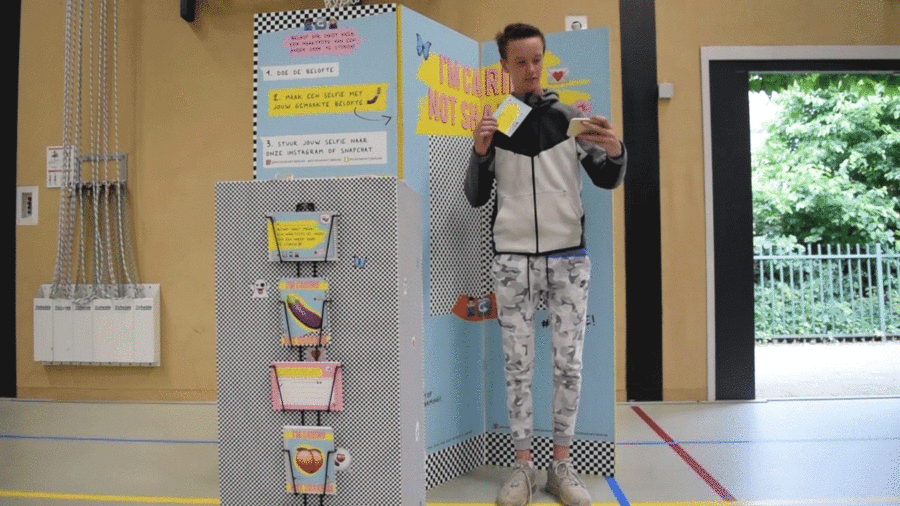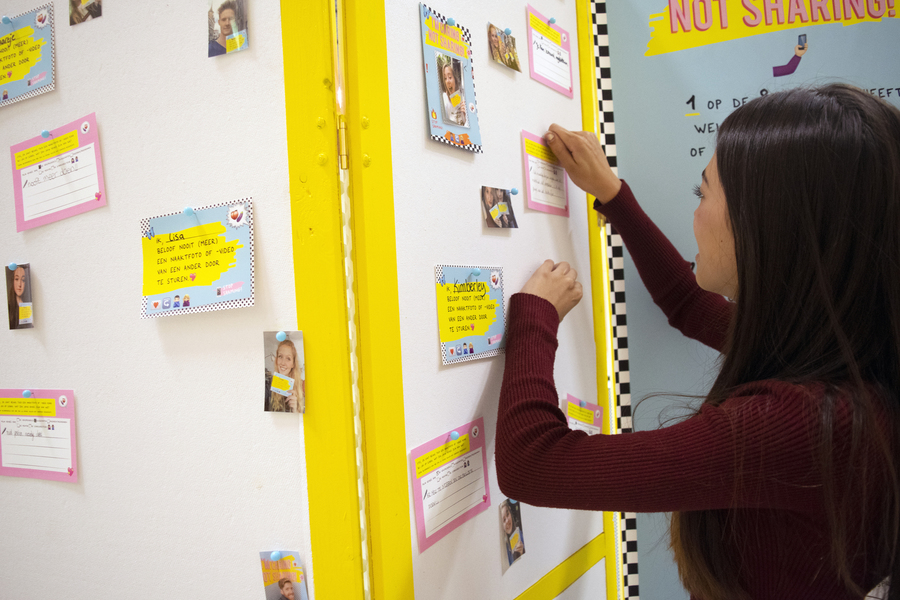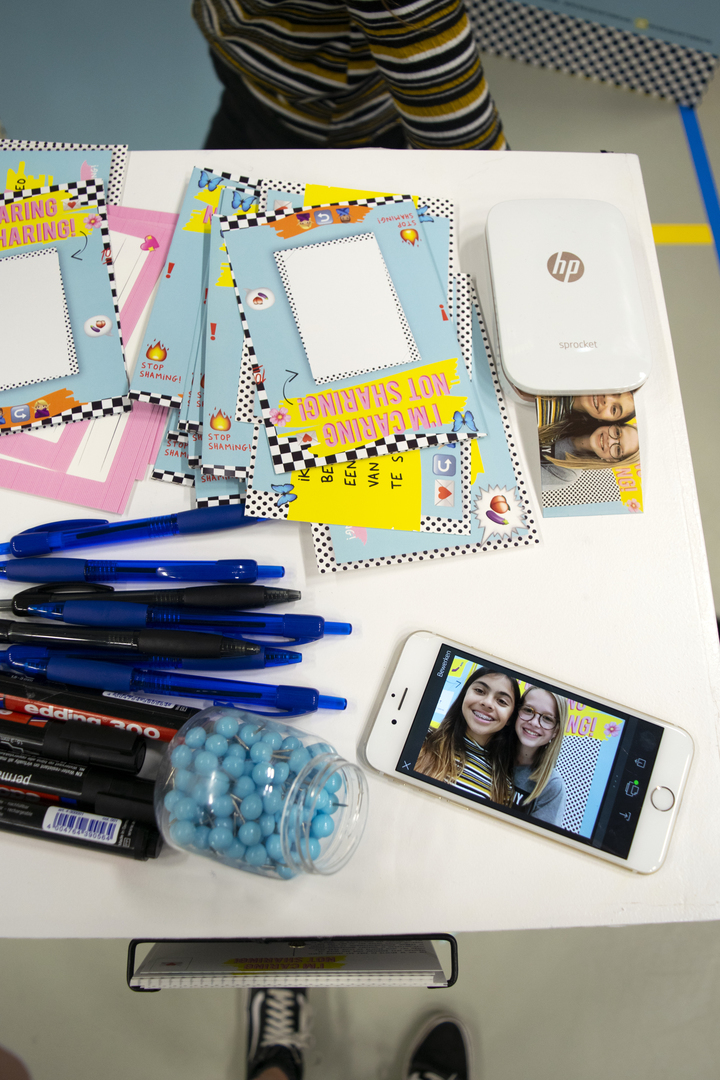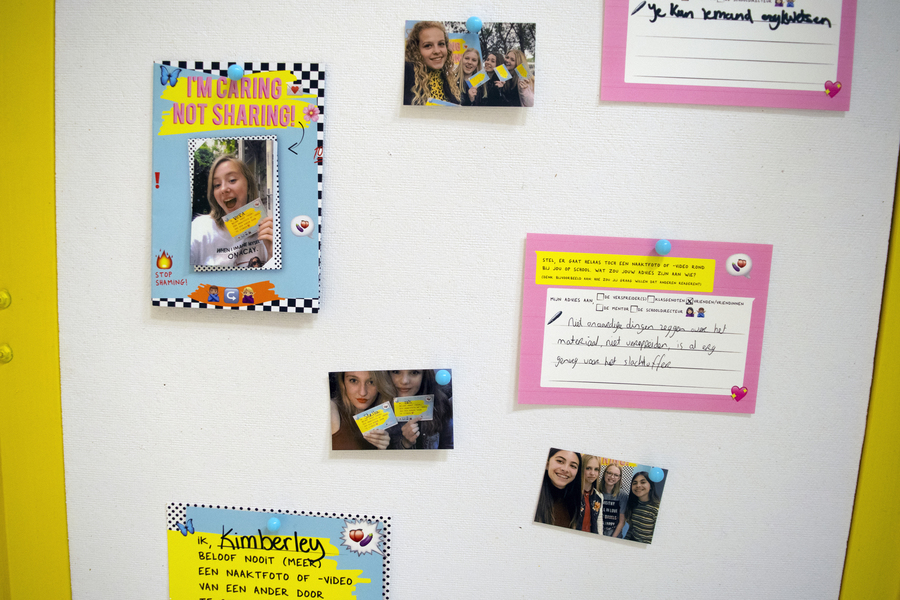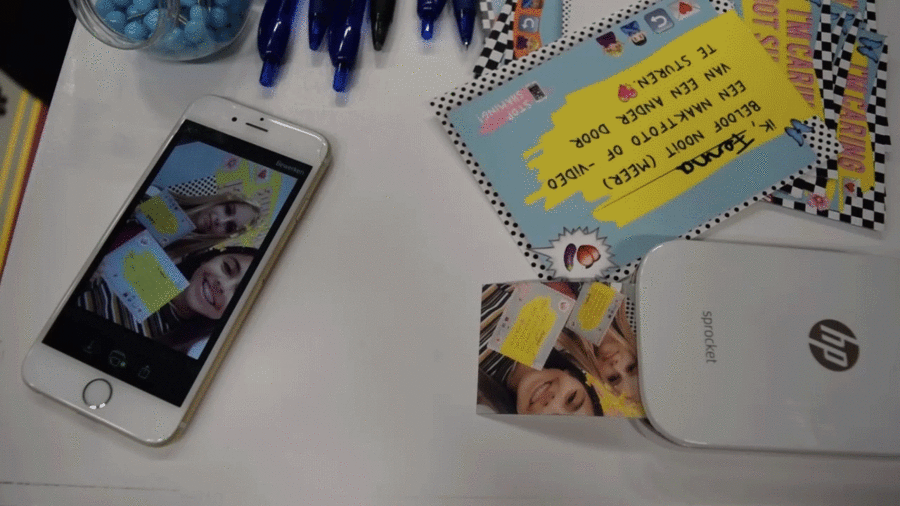Difference between revisions of "I'M CARING, NOT SHARING"
m (Text replacement - "{{GraduationYear selector |Year=2018 }}" to "{{Category selector |Category=2018 }}") |
|||
| (6 intermediate revisions by 3 users not shown) | |||
| Line 3: | Line 3: | ||
|Caption=FENNA IS #CARINGNOTSHARING | |Caption=FENNA IS #CARINGNOTSHARING | ||
|Summary=<small>Graduation project by Jasmijn Hoekman</small> | |Summary=<small>Graduation project by Jasmijn Hoekman</small> | ||
| + | <small>Nomination: Drempelprijs 2018</small> | ||
The interactive installation I'M CARING NOT SHARING, makes teenagers aware of their sharing behaviour. The general consensus about sexting is ‘it’s their own fault, when a nude photo leaks’ and ‘just don’t do it’. Because of all negative attention sexting seems to be a big problem among young people, even though it can be healthy experimental behaviour during sexual development. Complications arise only after a violation of trust; if the footage is spread or being used as blackmail. This is called shame sexting. This term is important, because the problem is not the sexting itself, but shaming of people is. Besides, the victim gets blamed, while he or she is not the one who sent it all over the world. '''Without spreaders, there would be no shame sexting!''' | The interactive installation I'M CARING NOT SHARING, makes teenagers aware of their sharing behaviour. The general consensus about sexting is ‘it’s their own fault, when a nude photo leaks’ and ‘just don’t do it’. Because of all negative attention sexting seems to be a big problem among young people, even though it can be healthy experimental behaviour during sexual development. Complications arise only after a violation of trust; if the footage is spread or being used as blackmail. This is called shame sexting. This term is important, because the problem is not the sexting itself, but shaming of people is. Besides, the victim gets blamed, while he or she is not the one who sent it all over the world. '''Without spreaders, there would be no shame sexting!''' | ||
[[File:Caring.jpg|.]] | [[File:Caring.jpg|.]] | ||
| + | {{#ev:youtube|ZaF5uj2dvoo}} | ||
|Article===Minor gamification== | |Article===Minor gamification== | ||
| − | In october 2017 I came across this article in the newspaper, ''"Onur (14) pleegt zelfmoord na ontdekken naaktfoto op Instagram"'' [https://www.ad.nl/binnenland/onur-14-pleegt-zelfmoord-na-ontdekken-naaktfoto-op-instagram~afdeae58/] this was the reason and start of my research and project during the minor gamification. A nude photo of a 14-year-old boy ended up online, he was feeling so ashamed, he committed suicide. Is this the new way of experimenting with sexuality? And what happened to all the kids who became victims? These questions were the startingpoint of my project. During the minor I designed Say What!?. This method involves different game elements, that trigger discussion among teenagers about sexting. Designed to be used in mentor classes at high schools. While participating in this game, pupils will develop empathy and may change their behavior towards the victims of sexting. Read more about this project in this article on Beyond Social: [http://beyond-social.org/wiki/index.php/Say_What!%3F Say What!?]. After my presentation at the Provoking Change event at Nieuwe Instituut I have had a brainstorm session with a number of professionals and other interested parties. I got a lot of feedback and tips on my current game. Because of this I found out | + | In october 2017 I came across this article in the newspaper, ''"Onur (14) pleegt zelfmoord na ontdekken naaktfoto op Instagram"'' [https://www.ad.nl/binnenland/onur-14-pleegt-zelfmoord-na-ontdekken-naaktfoto-op-instagram~afdeae58/] this was the reason and start of my research and project during the minor gamification. A nude photo of a 14-year-old boy ended up online, he was feeling so ashamed, he committed suicide. Is this the new way of experimenting with sexuality? And what happened to all the kids who became victims? These questions were the startingpoint of my project. During the minor I designed Say What!?. This method involves different game elements, that trigger discussion among teenagers about sexting. Designed to be used in mentor classes at high schools. While participating in this game, pupils will develop empathy and may change their behavior towards the victims of sexting. Read more about this project in this article on Beyond Social: [http://beyond-social.org/wiki/index.php/Say_What!%3F Say What!?]. After my presentation at the Provoking Change event at Nieuwe Instituut I have had a brainstorm session with a number of professionals and other interested parties. I got a lot of feedback and tips on my current game. Because of this I found out, this project was not finished yet, and especially I was not done with this subject yet. I noticed that when I talked to people about my project and the phenomenon of sexting, every time it resulted in a discussion. Everyone has an opinion about it, but actually does not know enough. Or rather, people often have only a one-sided view of sexting; It is dangerous, do not do it. That is why I decided to continue with this subject for my graduation project. I think it is important that not only the problems of sexting are highlighted. Because by doing so, it is precisely maintained that people are stupid when a nude photo is leaking. And that vicitm blaming is wrong. |
==Research== | ==Research== | ||
| Line 48: | Line 50: | ||
[[File:Prikbord2.jpg|.]] | [[File:Prikbord2.jpg|.]] | ||
[[File:Foto.gif]] | [[File:Foto.gif]] | ||
| − | [[File: | + | [[File:Instagramaccount.png]] |
| + | |||
| + | [[Category:Gradwork]][[Category:2018]] | ||
}} | }} | ||
{{Article Selection Overview | {{Article Selection Overview | ||
| Line 65: | Line 69: | ||
{{Category selector | {{Category selector | ||
|Category=Reframing | |Category=Reframing | ||
| + | }} | ||
| + | {{Category selector | ||
| + | |Category=2018 | ||
}} | }} | ||
{{Articles more}} | {{Articles more}} | ||
Latest revision as of 16:40, 14 June 2019
Nomination: Drempelprijs 2018
The interactive installation I'M CARING NOT SHARING, makes teenagers aware of their sharing behaviour. The general consensus about sexting is ‘it’s their own fault, when a nude photo leaks’ and ‘just don’t do it’. Because of all negative attention sexting seems to be a big problem among young people, even though it can be healthy experimental behaviour during sexual development. Complications arise only after a violation of trust; if the footage is spread or being used as blackmail. This is called shame sexting. This term is important, because the problem is not the sexting itself, but shaming of people is. Besides, the victim gets blamed, while he or she is not the one who sent it all over the world. Without spreaders, there would be no shame sexting!
Minor gamification
In october 2017 I came across this article in the newspaper, "Onur (14) pleegt zelfmoord na ontdekken naaktfoto op Instagram" [1] this was the reason and start of my research and project during the minor gamification. A nude photo of a 14-year-old boy ended up online, he was feeling so ashamed, he committed suicide. Is this the new way of experimenting with sexuality? And what happened to all the kids who became victims? These questions were the startingpoint of my project. During the minor I designed Say What!?. This method involves different game elements, that trigger discussion among teenagers about sexting. Designed to be used in mentor classes at high schools. While participating in this game, pupils will develop empathy and may change their behavior towards the victims of sexting. Read more about this project in this article on Beyond Social: Say What!?. After my presentation at the Provoking Change event at Nieuwe Instituut I have had a brainstorm session with a number of professionals and other interested parties. I got a lot of feedback and tips on my current game. Because of this I found out, this project was not finished yet, and especially I was not done with this subject yet. I noticed that when I talked to people about my project and the phenomenon of sexting, every time it resulted in a discussion. Everyone has an opinion about it, but actually does not know enough. Or rather, people often have only a one-sided view of sexting; It is dangerous, do not do it. That is why I decided to continue with this subject for my graduation project. I think it is important that not only the problems of sexting are highlighted. Because by doing so, it is precisely maintained that people are stupid when a nude photo is leaking. And that vicitm blaming is wrong.
Research
The research and this project will be mainly about the bystanders and the spreading of nude photos and videos; the forwarding behavior of teenagers. If young people are aware of this and are gradually stopping, then sexting does not have to be a problem anymore. Then it remains something nice between two people, without the shame and guilt. Therefore my research question for my graduation project: How can I, as a designer, design an interactive game/campaign/installation that informs young people in a positive way and let them think about their forwarding behavior?
Sexting
The word sexting comes from the words "sex" and "texting" which means to free translation the sending of sexual messages/photos and/or videos. As this description already suggests, this happens mainly from a mobile phone (a smartphone). A big dutch research 'Seks voor je 25e', shows that 1 in 4 boys and 1 in 5 girls have received a nude photo or video in the past six months. 1 in 8 teenagers has sent a nude photo or video in the past six months. About the forwarding behavior, this research shows that fewer than 1 in 20 teenagers have experienced that a nude or sex video of him or her was shown to or shared with others. However, it is more common that young people see images of others. Namely, 29% of boys and 20% of girls have seen a nude or video of a friend in the last six months.
In adolescence, teenagers start experimenting with sex. According to Justine Pardoen (editor-in-chief of Ouders Online and specialized in children and media), the making of these images fits in with the sexual development of children and therefore we should not problematize it. Young people can do sexting for many reasons, to experiment with their sexuality, to flirt or to show interest, to appear popular, or during a relationship. There may also be less nice reasons such as peer pressure and coercion, this is when sexting is a problem.
Different terms
Spreading of footage, is the turning point when the term sexting changes and becomes problematic. Shame and guilt play a major role here. These terms are important to mention because they are often confused with the original term, sexting:
Shame sexting
I wrote about this term before, often when the media informs about sexting, most of the time it is actually about shame sexting. Sexting can lead to shame sexting. When a voluntary nude photo or video stays between two people, this can be experienced as fun and is called sexting. But when this footage is spread, it becomes shame sexting. Especially young people do not see the consequences of spreading sexually explicit images. The second thing that often goes wrong here is that the victim gets blamed, while he or she is not the one who sent it all over the world. This is called victim blaming.
Sexting in media and education
Because I want to inform people positively about sexting, namely that it does not have to be problematic. I will first have a look at how people get informed and educated about sexting at all. Newspaper headlines are often sensation-oriented. Does your child make sex movies? Just assume! (RTL Nieuws), As a parent you deal with sexting and the dangers of the internet (RTL News), You can be put on sex websites', police warns against sexting (Omroep West), Sexting can follow you for life (Police site) and How do you maintain your child for sexting and cyberbullying? (NRC). Because of the media, it seems like sexting can only go wrong. Of course, a positive message not news. But in my opinion this broad concept of sexting is framed wrongly. It is too often about becoming a victim or going wrong. But people are not victims of their own photo or video, but victims of spreading.
Young people and sex are always seen as something dangerous, something for which we must protect young people. Especially when the internet and therefore social media are involved. Prohibiting seems the easiest, but not the right solution. And according to Els Rommes and Marijke Naezer of the Institute for Gender Studies in Nijmegen, it is also not necessary. "It does happen, however, and taking nude photos is often very useful. Teenagers get to know their own body, develop self-confidence, discover what is pleasant and less pleasant and enjoy it "(Kerstens).
"Making of these images fits in with the sexual development of children and therefore we should not problematize it" - Justine Pardoen
I discovered also in education campaigns sexting gets problematized. It is mostly only about warning them, just don’t do it. It is difficult to spread a positive message about sexting while you also want to warn them of the risks. Because yes, it can have big consequences. But if we stop everything that is risky, we can just as well stop driving. It is about who is addressed in these campaigns, in almost all cases this is the maker of a photo or video. While the spreaders are the 'culprits' when they spread a photo or video. In the media, in schools and social media, sexting got problematized and wrongly framed. I would like to see young people get a positive message about sexting, so that shame no longer has to arise. That the blame in the leakage of visual material will lie on the one who spreads a photo or video instead of the maker. Education and information should be more like this.
I’m caring not sharing
So that is why I designed this campaign/installation I’m caring not sharing. Here, teenagers can make a promise, to never share a nude photo or video of another person. Ultimately, this interactive installation is mainly about the thought, the promise they make. It is also a place to talk about sexting and forwarding behavior - to break taboos. It makes young people think about their behavior and encourages behavioral change in the long term. The installation could work well at a high school, but also other places where young people come. Sports clubs, events, etc. The message I'm caring not sharing must be shared, in contrast to sexually-tinted images. To spread this message, there is a hashtag #imcaringnotsharing on Instagram and as print material on cards to take with.
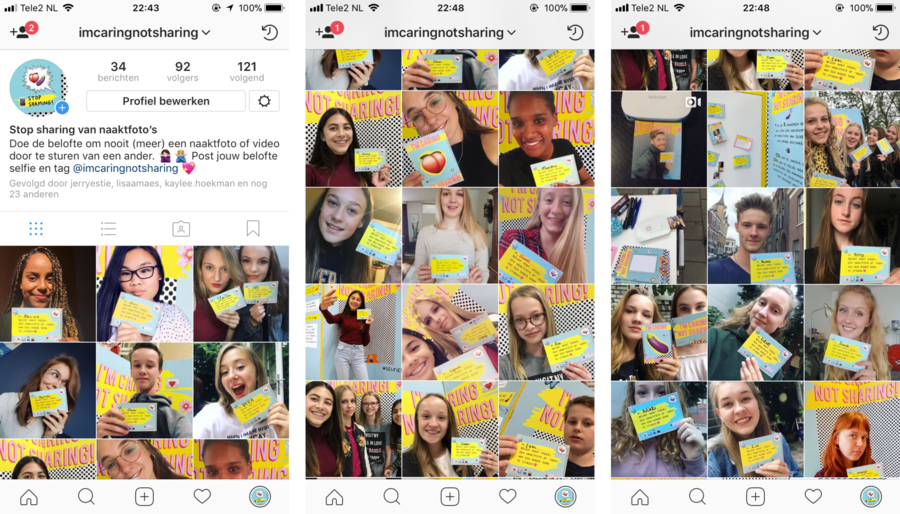
Links
CONTRIBUTE
Feel free to contribute to Beyond Social.
